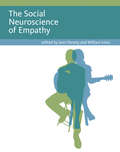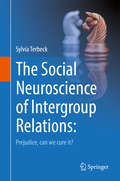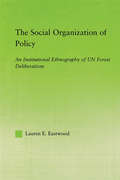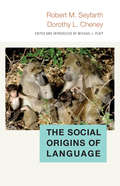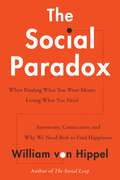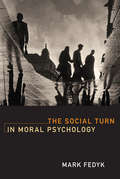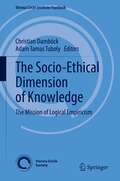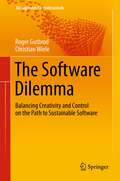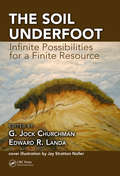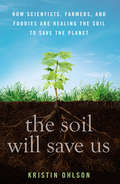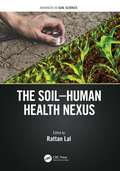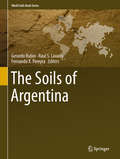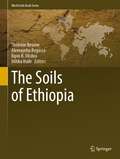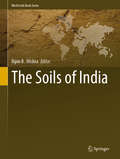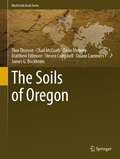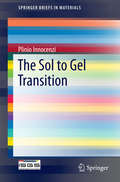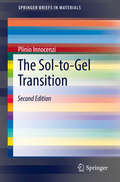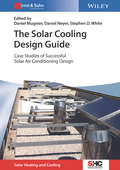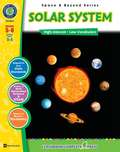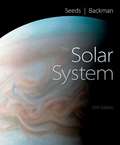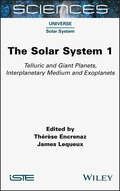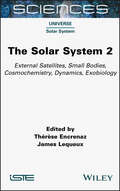- Table View
- List View
The Social Neuroscience of Empathy (Social Neuroscience)
by Jean Decety William IckesCross-disciplinary, cutting-edge work on human empathy from the perspectives of social, cognitive, developmental and clinical psychology and cognitive/affective neuroscience.In recent decades, empathy research has blossomed into a vibrant and multidisciplinary field of study. The social neuroscience approach to the subject is premised on the idea that studying empathy at multiple levels (biological, cognitive, and social) will lead to a more comprehensive understanding of how other people's thoughts and feelings can affect our own thoughts, feelings, and behavior. In these cutting-edge contributions, leading advocates of the multilevel approach view empathy from the perspectives of social, cognitive, developmental and clinical psychology and cognitive/affective neuroscience. Chapters include a critical examination of the various definitions of the empathy construct; surveys of major research traditions based on these differing views (including empathy as emotional contagion, as the projection of one's own thoughts and feelings, and as a fundamental aspect of social development); clinical and applied perspectives, including psychotherapy and the study of empathy for other people's pain; various neuroscience perspectives; and discussions of empathy's evolutionary and neuroanatomical histories, with a special focus on neuroanatomical continuities and differences across the phylogenetic spectrum. The new discipline of social neuroscience bridges disciplines and levels of analysis. In this volume, the contributors' state-of-the-art investigations of empathy from a social neuroscience perspective vividly illustrate the potential benefits of such cross-disciplinary integration.ContributorsC. Daniel Batson, James Blair, Karina Blair, Jerold D. Bozarth, Anne Buysse, Susan F. Butler, Michael Carlin, C. Sue Carter, Kenneth D. Craig, Mirella Dapretto, Jean Decety, Mathias Dekeyser, Ap Dijksterhuis, Robert Elliott, Natalie D. Eggum, Nancy Eisenberg, Norma Deitch Feshbach, Seymour Feshbach, Liesbet Goubert, Leslie S. Greenberg, Elaine Hatfield, James Harris, William Ickes, Claus Lamm, Yen-Chi Le, Mia Leijssen, Abigail Marsh, Raymond S. Nickerson, Jennifer H. Pfeifer, Stephen W. Porges, Richard L. Rapson, Simone G. Shamay-Tsoory, Rick B. van Baaren, Matthijs L. van Leeuwen, Andries van der Leij, Jeanne C. Watson
The Social Neuroscience of Intergroup Relations:
by Sylvia TerbeckThe Social Neuroscience of Intergroup Relations; Prejudice can we cure it?" is a highly interdisciplinary book. It includes latest theories and research from: Social Psychology, Ethics, Psychopharmacology, as well as Social Neuroscience. The book is also based on the author's team research. The book describes experimental studies which have suggested that fear of the out-group might play a role in prejudice. Amongst others, one experiment that received large media coverage will be illustrated; a study which found that the drug propranolol reduced racial bias. However, is there a "cure" for prejudice? But even if there were biological methods to reduce prejudice are there not ethical and medical problems associated with this? However, we are our brain; thus not only soul searching, but also a drug can change the core of a person.
The Social Organization of Policy: An Institutional Ethnography of UN Forest Deliberations (New Approaches in Sociology)
by Lauren E. EastwoodThis book provides a specific case study--based upon direct research with UN processes--which enables the reader to situate larger theoretical arguments regarding civil society, globalization, and sustainable development within the context of the actual activities of practitioners working within the UN forest policy-making arena.
The Social Origins of Language
by Robert M. Seyfarth Dorothy L. Cheney Michael L. PlattHow human language evolved from the need for social communicationThe origins of human language remain hotly debated. Despite growing appreciation of cognitive and neural continuity between humans and other animals, an evolutionary account of human language—in its modern form—remains as elusive as ever. The Social Origins of Language provides a novel perspective on this question and charts a new path toward its resolution.In the lead essay, Robert Seyfarth and Dorothy Cheney draw on their decades-long pioneering research on monkeys and baboons in the wild to show how primates use vocalizations to modulate social dynamics. They argue that key elements of human language emerged from the need to decipher and encode complex social interactions. In other words, social communication is the biological foundation upon which evolution built more complex language.Seyfarth and Cheney’s argument serves as a jumping-off point for responses by John McWhorter, Ljiljana Progovac, Jennifer E. Arnold, Benjamin Wilson, Christopher I. Petkov and Peter Godfrey-Smith, each of whom draw on their respective expertise in linguistics, neuroscience, philosophy, and psychology. Michael Platt provides an introduction, Seyfarth and Cheney a concluding essay. Ultimately, The Social Origins of Language offers thought-provoking viewpoints on how human language evolved.
The Social Paradox: Autonomy, Connection, and Why We Need Both to Find Happiness
by William von HippelA Next Big Idea Club Must Read of February 2025From the author of The Social Leap comes this thought-provoking exploration into humans’ two core evolutionary needs, for connection and autonomy, how the modern world has thrown them out of whack, and how we can rebalance them to improve our lives.Why do people who have so much—leading comfortable lives filled with unprecedented freedom, choice, and abundance—often feel so unhappy and unfulfilled? This phenomenon is a defining paradox of our time and one we endlessly seek to solve. In The Social Paradox, psychologist William von Hippel argues that we need to think about this problem in a new way. By changing our perspective, we might finally see the solution, bringing us greater happiness and more satisfying relationships.The key is to understand the interplay between our two most basic psychological needs—for connection and autonomy. Evolution made us dependent on one another for survival, instilling in us a strong need to connect. It also made us seek autonomy, so our ancestors could distinguish themselves within their groups, improving their chances to procreate and gain status.These two opposing needs are our most fundamental psychological drivers, and while our lives once ensured a happy balance between them, the opportunities of today’s world have thrown it out of whack. As von Hippel explains, our modern world no longer demands connection but it provides endless opportunity for autonomy; this lopsidedness lies at the root of many of our most intractable problems. Recognizing this imbalance and working to counter it can drastically change how we make decisions, spend our time, and find happiness.The Social Paradox invites us to examine the fundamental building blocks of life and society—politics, religion, urban living, marriage—in a brand-new way. Once we understand the evolutionary forces driving us, we can begin to see how to counteract the emptiness and loneliness of contemporary life.
The Social Turn in Moral Psychology (The\mit Press Ser.)
by Mark FedykAn argument that moral psychology can benefit from closer integration with the social sciences, offering a novel ethical theory bridging the two.In this book, Mark Fedyk offers a novel analysis of the relationship between moral psychology and allied fields in the social sciences. Fedyk shows how the social sciences can be integrated with moral philosophy, argues for the benefits of such an integration, and offers a new ethical theory that can be used to bridge research between the two. Fedyk argues that moral psychology should take a social turn, investigating the psychological processes that motivate patterns of social behavior defined as ethical using normative information extracted from the social sciences. He points out methodological problems in conventional moral psychology, particularly the increasing methodological and conceptual inconsilience with both philosophical ethics and evolutionary biology. Fedyk's “causal theory of ethics” is designed to provide moral psychology with an ethical theory that can be used without creating tension between its scientific practice and the conceptual vocabulary of philosophical ethics. His account aims both to redirect moral psychology toward more socially realistic questions about human life and to introduce philosophers to a new form of ethical naturalism—a way of thinking about how to use different fields of scientific research to answer some of the traditional questions that are at the heart of ethics.
The Society of Genes
by Itai Yanai Lercher MartinSince Dawkins popularized the notion of the selfish gene, the question of how these selfish genes work together to construct an organism remained a mystery. Now, standing atop a wealth of new research, Itai Yanai and Martin Lercher--pioneers in the field of systems biology--provide a vision of how genes cooperate and compete in the struggle for life.
The Socio-Ethical Dimension of Knowledge: The Mission of Logical Empiricism (Vienna Circle Institute Yearbook #26)
by Christian Damböck Adam Tamas TubolyThis book studies how the relationship between philosophy, morality, politics, and science was conceived in the Vienna Circle and how this group of philosophers tried to position science as an antidote to totalitarianism and irrationalism. This leads to investigation of the still understudied views of the Vienna Circle on moral philosophy, meta-ethics, and the relationship between philosophy of science and politics. Including papers from an international group of scholars, The Socio-ethical Dimension of Knowledge: The Mission of Logical Empiricism addresses these topics and makes them available to scholars in the field of history of philosophy of science.
The Software Dilemma
by Christian Wiele Roger GutbrodThe complexity of software is continuously growing as a result of today's interconnected business processes. Governance of architecture and technology strategy helps to ensure coherence of software and avoid excessive complexity. At the same time software development needs room for creativity and empowerment to provide solutions to business problems of increasing complexity. The book looks at this software dilemma from the perspectives of CIOs/CTOs, software architects, and auditors. Each of these groups has different interests which need to be considered, reconciled, and balanced. CIOs/CTOs are provided with the boundary conditions they have to establish assuring the achievement of strategic objectives. Architects and auditors find proven concepts for effectively assessing software projects and architectures, as well as for effectively communicating identified issues to responsible persons. The book is based on the author's long experience in software engineering, governance, and auditing.
The Soil Underfoot: Infinite Possibilities for a Finite Resource
by Edward R. Landa G. Jock ChurchmanThe largest part of the world's food comes from its soils, either directly from plants, or via animals fed on pastures and crops. Thus, it is necessary to maintain, and if possible, improve the quality-and hence good health-of soils, while enabling them to support the growing world population. The Soil Underfoot: Infinite Possibilities for a Finite
The Soil Will Save Us: How Scientists, Farmers, and Foodies Are Healing the Soil to Save the Planet
by Kristin OhlsonThousands of years of poor farming and ranching practices—and, especially, modern industrial agriculture—have led to the loss of up to 80 percent of carbon from the world's soils. That carbon is now floating in the atmosphere, and even if we stopped using fossil fuels today, it would continue warming the planet. In The Soil Will Save Us, journalist and bestselling author Kristin Ohlson makes an elegantly argued, passionate case for "our great green hope"—a way in which we can not only heal the land but also turn atmospheric carbon into beneficial soil carbon—and potentially reverse global warming.As the granddaughter of farmers and the daughter of avid gardeners, Ohlson has long had an appreciation for the soil. A chance conversation with a local chef led her to the crossroads of science, farming, food, and environmentalism and the discovery of the only significant way to remove carbon dioxide from the air—an ecological approach that tends not only to plants and animals but also to the vast population of underground microorganisms that fix carbon in the soil. Ohlson introduces the visionaries—scientists, farmers, ranchers, and landscapers—who are figuring out in the lab and on the ground how to build healthy soil, which solves myriad problems: drought, erosion, air and water pollution, and food quality, as well as climate change. Her discoveries and vivid storytelling will revolutionize the way we think about our food, our landscapes, our plants, and our relationship to Earth.
The Soil-Human Health-Nexus (ISSN)
by Rattan LalThe term "soil health" refers to the functionality of a soil as a living ecosystem capable of sustaining plants, animals, and humans while also improving the environment. In addition to soil health, the environment also comprises the quality of air, water, vegetation, and biota. The health of soil, plants, animals, people, and the environment is an indivisible continuum. One of the notable ramifications of the Anthropocene is the growing risks of decline in soil health by anthropogenic activities. Important among these activities are deforestation, biomass burning, excessive soil tillage, indiscriminate use of agrochemicals, excessive irrigation by flooding or inundation, and extractive farming practices. Soil pollution, by industrial effluents and urban waste adversely impacts human health. Degradation of soil health impacts nutritional quality of food, such as the uptake of heavy metals or deficit of essential micro-nutrients, and contamination by pests and pathogens. Indirectly, soil health may impact human health through contamination of water and pollution of air.This book aims to:Present relationships of soil health to human health and soil health to human nutrition. Discuss the nexus between soil degradation and malnourishment as well as the important links between soil, plant, animal and human health. Detail reasons oil is a cause of infectious diseases and source of remedial measures.Part of the Advances in Soil Sciences series, this informative volume covering various aspects of soil health appeals to soil scientists, environmental scientists and public health workers.
The Soils of Argentina (World Soils Book Ser.)
by Gerardo Rubio Raul S. Lavado Fernando X. PereyraThis is the first comprehensive book on Argentinian pedology. It discusses the main soil types of Argentina, their geographical distribution, classification, functions, agricultural use, ecological aspects, and the threats to which they have been subjected during centuries of intensive and extensive management. The description of the soils is accompanied by a complete set of data, pictures and maps, including benchmark profiles and an overview of the country's agricultural production. It also deals with future scenarios of the relationships between soil science and other disciplines and the main challenges that soil science will face in the future. Further, the book explores aspects of the main soil forming factors, such as climate, vegetation, geology and geomorphology, making use of new, unpublished data and elaborations, and presents a history of pedological research in Argentina.
The Soils of Ethiopia (World Soils Book Series)
by Bipin B. Mishra Sheleme Beyene Alemayehu Regassa Mitiku HaileThis book addresses Ethiopia's extremely rich soil diversity and resources, which have developed under various climatic conditions. Featuring contributions by a group of respected experts on Ethiopian soils and agriculture, it provides comprehensive information on the management approaches needed for sustainable soil utilization and conservation under such conditions and the attendant challenges. It offers a valuable resource for anyone interested in soils and agriculture in Ethiopia, but also in other African countries with similar climatic conditions. The book contains 13 chapters which illustrate the long history of knowledge and soil research; climate; geology and geomorphology; soil forming factors, processes, and classification; major soil types, their properties, fertility status, and management; land evaluation and land use planning; soils and society/industry; and future/emerging soil issues.
The Soils of India (World Soils Book Series)
by Bipin B. MishraThis book provides an overview of the diversified soil regimes in India. In addition to the historical advances in soil research and its limitations, it describes the monitoring of various soil conditions and soil uses to improve productivity. Discussing topics such as climate, geology and geomorphology, major soil types and their classification, soil mineralogy and clays, soil micromorphology, soil biogeochemistry, benchmark soils, land evaluation and land use planning, soil health and fertility and soil resilience, the book highlights the multiple uses of soils in industry, human health care, mitigation of challenges due to climate change and construction. It also presents measures for a brighter future of soil science in India, such as imposing organic farming principles toward sustainable agriculture in the context of the second green revolution besides alleviating the poverty and providing the employment opportunities among the farming communities in India.
The Soils of Nevada (World Soils Book Series)
by James G. Bockheim Joseph V. Chiaretti Paul W. Blackburn John B. Fisher William E. Dollarhide Douglas J. MerklerThis book discusses Nevada in the context of the history of soil investigations; soil-forming factors; general soil regions; soil geomorphology; taxonomic structure of the soils; taxonomic soil regions; soil-forming processes; benchmark, endemic, rare, and endangered soils; and use of soils.With an average mean annual precipitation of 175 mm (7 in), Nevada is the driest state in the USA. More than three-quarters (89%) of the state has been mapped and the first soil survey was completed in 1909. Nevada is divided into 10 major land-resource areas and features two large deserts (the Great Basin Desert and the Mojave Desert), and over 100 north–south trending enclosed basins separated by mountain ranges (Basin and Range Province), several of which have peaks exceeding 3,400 m. Further, the soils of Nevada represent seven of the 12 globally recognized orders, 29 suborders, 69 great groups, and over 1,800 soil series, and some of the classic research on the origin of duripans and petrocalcic horizons was conducted in the state. This book presents the first report on the soils of Nevada and provides the first soil map of Nevada utilizing soil.
The Soils of Oregon (World Soils Book Series)
by Steven Campbell James G. Bockheim Thor Thorson Chad McGrath Dean Moberg Matthew Fillmore Duane LammersThis book is the only comprehensive summary of natural resources of Oregon and adds to World Soil Book Series state-level collection. Due to broad latitudinal and elevation differences, Oregon has an exceptionally diverse climate, which exerts a major influence on soil formation. The mean annual temperature in Oregon ranges from 0°C in the Wallowa and Blue Mountains of northeastern Oregon to 13 °C in south-central Oregon. The mean annual precipitation ranges from 175 mm in southeastern Oregon to over 5,000 mm at higher elevations in the Coast Range. The dominant vegetation type in Oregon is temperate shrublands, followed by forests dominated by lodgepole pine, Douglas-fir, and mixed conifers, grasslands, subalpine forests, maritime Sitka spruce-western hemlock forests, and ponderosa pine-dominated forests. Oregon is divided into 17 Major Land Resource Areas, the largest of which include the Malheur High Plateau, the Cascade Mountains, the Blue Mountain Foothills, and Blue Mountains. The single most important geologic event in Oregon was the deposition of Mazama ash 7,700 years by the explosion of Mt. Mazama. Oregon has soil series representative of 10 orders, 40 suborders, 114 great groups, 389 subgroups, over 1,000 families, and over 1,700 soil series. Mollisols are the dominant order in Oregon, followed by Aridisols, Inceptisols, Andisols, Ultisols, and Alfisols. Soils in Oregon are used primarily for forest products, livestock grazing, agricultural crops, and wildlife management. Key land use issues in Oregon are climate change; wetland loss; flooding; landslides; volcanoes, earthquakes, and tsunamis; coastal erosion; and wildfires.
The Sol to Gel Transition
by Plinio InnocenziThis book provides an in-depth introduction to the sol to gel transition in inorganic and hybrid organic-inorganic systems, one of the most important chemical-physical transitions and the basis of the sol-gel process. Familiarity with the fundamental chemistry and physics of this transition is essential for students in chemistry and materials science through academic and industry researchers working on sol-gel-related applications. The book features a didactic approach, using simple and clear language to explain the sol to gel transition and the accompanying processes. The text is also suitable for use in short courses and workshops for graduate students as well as professionals.
The Sol-to-Gel Transition (SpringerBriefs in Materials)
by Plinio InnocenziThis book provides an in-depth introduction to the sol to gel transition in inorganic and hybrid organic-inorganic systems, one of the most important chemical-physical transitions and the basis of the sol-gel process. Familiarity with the fundamental chemistry and physics of this transition is essential for students in chemistry and materials science through academic and industry researchers working on sol-gel-related applications. The book features a didactic approach, using simple and clear language to explain the sol to gel transition and the accompanying processes. The text is also suitable for use in short courses and workshops for graduate students as well as professionals.This fully revised and updated new edition contains a wealth of new content. In particular, it includes a detailed discussion of the chemistry of transition metal alkoxides and organosilanes, and an extended discussion of the sol to gel transition models.
The Solar Cooling Design Guide: Case Studies of Successful Solar Air Conditioning Design (Solar Heating and Cooling)
by Stephen White Daniel Mugnier Daniel NeyerSolar cooling systems can be a cost-effective and environmentally attractive air-conditioning solution. The design of such systems, however, is complex. Research carried out under the aegis of the International Energy Agency's Solar Heating and Cooling Program has shown that there is a range of seemingly subtle design decisions that can impact significantly on the performance of solar cooling systems. In order to reduce the risk of errors in the design process, this guide provides detailed and very specific engineering design information. It focuses on case study examples of installed plants that have been monitored and evaluated over the last decade. For three successful plants the design process is described in detail and the rationale for each key design decision is explained. Numerical constraints are suggested for the sizing / selection parameters of key equipment items. Moreover, the application conditions under which the system selection is appropriate are discussed. By following The Guide for any of the three specific solar cooling systems, the designer can expect to reliably achieve a robust, energy-saving solution. This book is intended as a companion to the IEA Solar Cooling Handbook which provides a general overview of the various technologies as well as comprehensive advice to enable engineers to design their own solar cooling system from first principles.
The Solar System
by Charlene HomerThis book provides ready-to-use information and activities for remedial students in grades five to eight. Written to grade using simplified language and vocabulary, science concepts are presented in a way that makes them more accessible to students and easier to understand. Comprised of reading passages, student activities and overhead transparencies, our resource can be used effectively for whole-class, small group and independent work.
The Solar System
by Steck-VaughnThis book contains a lot of amazing facts and figures about the Solar System.
The Solar System (Tenth Edition)
by Michael A. Seeds Dana E. BackmanEmphasizes the scientific method throughout as it guides students to answer two fundamental questions: What are we? And how do we know? In addition to exploring the newest developments and latest discoveries in the exciting field of Astronomy, authors Seeds and Backman discuss the interplay between evidence and hypothesis, providing both factual information and a conceptual framework for understanding the logic of science.
The Solar System 1: Telluric and Giant Planets, Interplanetary Medium and Exoplanets
by James Lequeux Thérèse EncrenazThis book presents a global and synthetic vision of planetology – the study of objects in the Solar System. In the past several decades, planetology has undergone a real revolution, marked in particular by the discovery of the Kuiper belt beyond Neptune, the discovery of extrasolar planets, and also by the space exploration of ever more distant objects. Today, it is at the crossroads of many disciplines: astronomy, geophysics, geochemistry and biology. The Solar System 1 deals with the Solar System as a whole, offering a general presentation of the objects that compose it and its place in the galaxy. It also deals with planetary systems, exoplanets and the interaction of Solar System objects with interplanetary medium. Finally, it analyzes the telluric and giant planets.
The Solar System 2: External Satellites, Small Bodies, Cosmochemistry, Dynamics, Exobiology
by James Lequeux Thérèse EncrenazThis book presents a global and synthetic vision of planetology – the study of objects in the Solar System. In the past several decades, planetology has undergone a real revolution, marked in particular by the discovery of the Kuiper belt beyond Neptune, the discovery of extrasolar planets, and also by the space exploration of ever more distant objects. Today, it is at the crossroads of many disciplines: astronomy, geophysics, geochemistry and biology.The Solar System 2 studies the outer Solar System: satellites and rings of giant planets, small bodies and dwarf planets. It also deals with meteorites and cosmochemistry, as well as the formation and dynamics of the Solar System. It addresses the question of the origin of life and extraterrestrial life, and presents all of the methods in the study of planetology.
